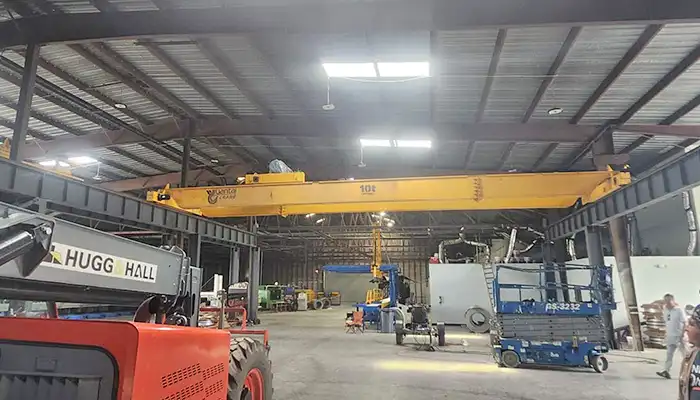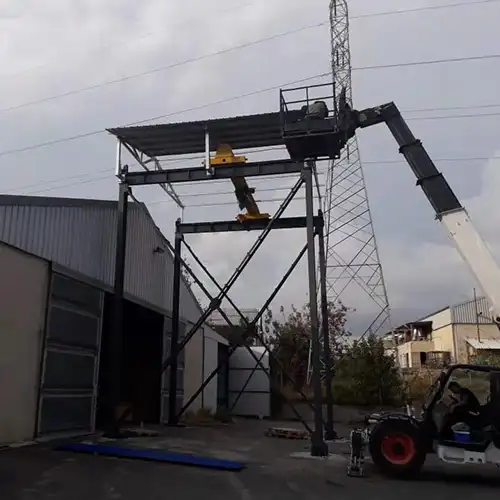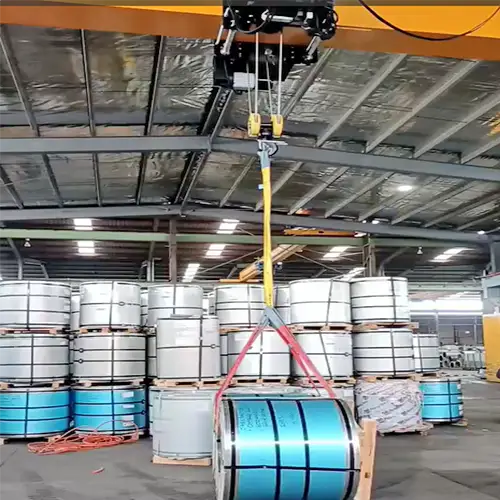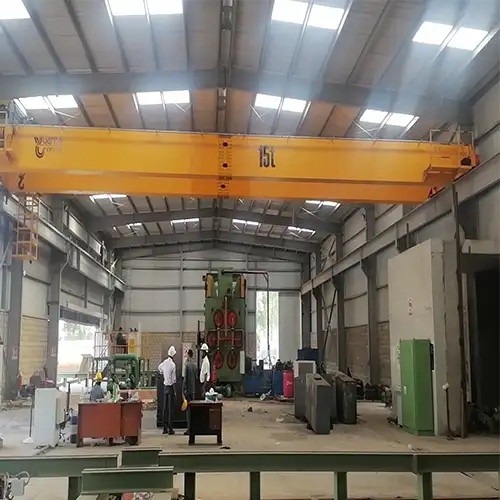2 Ton Free Standing Bridge Crane Type, Specs, Layout & Selection
2 ton freestanding crane for sale. Check design options, technical specs, layout tips & quotation steps for choosing right 2-ton freestanding bridge crane.
Category: Featured
Your Trusted Overhead Bridge Crane Manufacturer & Supplier
Freestanding Bridge Cranes and Overhead Crane for Sales
2 Ton Free Standing Bridge Crane Type, Specs, Layout & Selection
2 ton freestanding crane for sale. Check design options, technical specs, layout tips & quotation steps for choosing right 2-ton freestanding bridge crane.
A 2-ton free standing bridge crane is a self-supporting overhead lifting system that doesn't rely on your building's structure. It's built from the ground up, literally — with support columns, beams, and a bridge girder — and can be placed anywhere there's enough floor space and a strong foundation.
It's commonly used in light-duty industrial tasks. You'll see them in metal workshops, auto repair shops, maintenance zones, or any place where small but frequent lifting is part of the daily workflow.
Why Is 2 Ton So Popular?
Because it's just enough without being overkill. A 2-ton capacity hits the sweet spot between too small and too heavy.
- Perfect for lifting items like engine blocks, fabricated parts, toolboxes, molds, or machinery components
- Small footprint — doesn't require a huge installation area or high roof clearance
- Lower weight means less stress on the crane structure and a smoother lifting experience
- More affordable than heavier models and often quicker to install
If you're not dealing with heavy steel coils or giant assemblies, 2 tons is often more than enough to get the job done safely.
Why Go for a Free Standing Design?
Sometimes your building just doesn't cooperate. Maybe the roof isn't strong enough. Maybe it's a rented facility. Or maybe you're planning to expand in the future and need something flexible.
That's when a free standing bridge crane starts to make real sense.
- No need for existing building support — it carries its own weight
- Easy to position where you actually need it — workstations, loading zones, small production lines
- A smart choice for temporary or modular workshops — it can be relocated or modified if needed
- Works in both low-ceiling and wide-open facilities
Think of it this way: if your building isn't ready for an overhead crane, this option makes your crane ready for your building.
2 Ton Freestanding Bridge Crane Design Options
Not all freestanding cranes are built the same. Depending on your workspace layout, lifting height, and how loads move across your floor, there are a few design options to consider. Here's a breakdown of the three most common types for a 2-ton setup — each with its own strengths and use cases.

Top Running Free Standing Bridge Crane
This is the more traditional setup. The bridge crane travels on top of the runway beam, which itself is supported by the freestanding columns. It's built for performance where lifting height and clear access matter.
- Description: Bridge travels along the top flange of the runway beam
- Best for: When higher headroom and greater hook coverage are needed
Advantages:
- Maximizes lifting height — great when vertical clearance is important
- Better hook approach at both ends of the span
- Handles longer spans more easily than underhung cranes
Common Applications:
- Light machinery manufacturing
- Small to mid-sized assembly lines
- Tool and die handling where space under the hook is valuable

Underhung (Under Running) Free Standing Bridge Crane
This design flips things around — the crane hangs from the bottom flange of the runway. It's often used in buildings with limited headroom where every inch matters.
- Description: Crane is suspended from underneath the beam, rather than riding on top
- Best for: Facilities with low ceilings or where headroom is tight
Advantages:
- More compact — ideal when the building structure limits overhead space
- Easier to install and align due to lighter design
- Typically more affordable for shorter spans
Common Applications:
- Maintenance bays
- Machine service shops
- Workstations with ceiling height restrictions

KBK Crane Type Free Standing Crane System
This one's in a league of its own — a modular crane made from lightweight aluminum or steel profiles. It's often used for manual or assisted lifting in repetitive, ergonomic work environments.
- Description: Pre-engineered system with low-friction profiles and trolley movement
- Best for: Manual handling, light-duty lifting, and high-cycle work areas
Advantages:
- Very low push/pull force needed — one person can handle the load easily
- Clean, quiet operation with minimal maintenance
- Can be customized into ceiling-mounted or freestanding setups
Common Applications:
- Automotive component assembly
- Packing and sorting stations
- Laboratories or testing centers needing precise movement
Each of these crane types solves a slightly different problem. The key is knowing how much space you have, how often you'll lift, and how far the load needs to travel. Then choose the type that fits your workflow best.
Key Benefits of a 2 Ton Free Standing Bridge Crane
A 2-ton free standing bridge crane isn't just a compact lifting solution — it's a flexible tool that adapts to your workspace, not the other way around. Whether you're operating in a small fabrication shop or a light-duty assembly zone, this crane brings practical advantages that are hard to ignore.
Independent of Building Structure
This is one of the biggest selling points. You don't need to worry about whether your ceiling can support a crane — because it doesn't have to.
- The entire system stands on its own columns and runway beams
- Ideal for rented buildings, older facilities, or steel sheds with no ceiling load capacity
- Reduces structural load concerns and the need for costly building reinforcements
Easy to Relocate or Expand
Let's say your layout changes. Or you're moving to a bigger place. Or maybe your work area grows over time. No problem.
- The modular design allows for future expansion or modification
- Can be disassembled and reinstalled at a new site if needed
- A great option for mobile workshops, temporary production lines, or testing areas
Optimized for Indoor Layouts and Small Workshops
If space is tight or your workflow follows a specific pattern, the crane adapts to it — not the other way around.
- Can be configured to fit narrow aisles, specific bays, or tight floor plans
- Doesn't block other equipment or lighting like floor-mounted jib cranes sometimes do
- Smooth trolley movement makes it easy to move loads from one point to another, even in confined areas
Simple Installation with Minimal Disruption
No one likes major downtime or complicated installations. A free standing bridge crane goes up without turning your shop into a construction zone.
- Requires only anchor bolts and a flat concrete foundation
- Installation can usually be done in days, not weeks
- Keeps your other operations running while the crane is being set up
In short, this crane is built for convenience. It fits where others can't, works when others won't, and gives you lifting ability without locking you into one layout forever.
Layout Considerations when Use Freestanding Bridge Cranes
Before putting a 2-ton freestanding bridge crane into your workspace, it's worth spending time on the layout. A well-planned layout saves you headaches down the line — from awkward hook positions to structural issues. Here are the key points you'll want to look at:
Column Spacing and Span
This is the first thing to decide. How far apart will the columns be? The wider the span, the fewer columns you need — but the more robust the crane structure must be.
- Standard spans for 2-ton systems often range from 5 to 12 meters
- Too many columns can block floor access; too few can drive up steel costs
Tip: Try to match column spacing with existing floor grid or equipment layout.
Lifting Height and Building Clearance
Don't forget to check how much space you really have above the load. That includes room for the hoist, trolley, and hook movement.
- Think from ground to hook — not just ceiling height
- Top-running cranes give you more lifting height
- Underhung cranes save space but sacrifice headroom
If you're working under a mezzanine or inside a small workshop, this is especially important.
Hook Approach (End and Side)
Hook approach refers to how close the crane hook can get to the ends or sides of the span. It affects whether you can reach loads in tight corners or near walls.
- Good end approach = less dead zone
- Poor side approach = wasted floor space
For tight workshops, optimizing this makes a big difference in actual usable lifting area.
Floor Loading and Foundation Requirements
A freestanding crane puts all its weight — plus the load — directly onto the floor. Make sure your floor can handle it.
- You may need to check concrete thickness and reinforcement
- In some cases, steel base plates or anchor bolts are required
- Lightweight KBK systems may need minimal prep
If you're installing the crane in an older building or mezzanine, get this checked first.
Electrical Power Supply Route
Plan how power will reach the hoist and control system. Overhead cable festoons? Conduit from the wall? Or maybe a plug-and-play setup?
- Check for the nearest panel or distribution box
- Allow space for cable support tracks if using long spans
- Don't forget grounding and safety disconnects
Sometimes, it's easier to run power along the runway than drop it from the ceiling.
Integration with Workstation Flow
A crane that blocks your workflow isn't helping — no matter how well it lifts.
- Map out how materials move from one station to another
- Place columns where they won't interrupt carts, forklifts, or foot traffic
- Think ahead: Will you need to expand or relocate in the future?
Design with your people and process in mind. A little foresight now means a smoother, safer operation later.
Get these layout details right from the start, and your freestanding crane becomes part of the workflow — not an obstacle in it.
| Comparison Item | Top Running | Underhung | KBK Type |
|---|---|---|---|
| Max Span | Up to 10m | Up to 8m | 2 to 7m |
| Lifting Height | Fully customizable Depends on building height | Limited by ceiling or beam clearance | Generally low Light-duty loads |
| Headroom Required | More overhead clearance Lower headroom | Compact design Fits tight height spaces | Minimal headroom Needed |
| Installation Style | Floor-mounted Columns support runway | Floor-mounted columns or ceiling hung | Modular system Floor-fixed supports |
| Travel Type | Motorized or manual trolley travel | Manual or electric trolley travel | Manual or semi-electric operation |
When to Select Right Freestanding Crane Design for Your Need
Picking the right crane design comes down to your specific space and lifting needs. Here's a quick guide to help you decide:
Choose Top Running When…
You need higher lifting height and longer spans. This design is built to handle heavier loads and gives you better hook clearance, making it great for demanding industrial work.
- Best for heavy-duty tasks and taller buildings
- Perfect when maximizing vertical lifting space matters
- Ideal for facilities planning future expansion or longer crane travel
Choose Underhung When…
Your facility has limited headroom or if you want to reduce costs without sacrificing basic overhead lifting functionality.
- Works well in workshops with low ceilings
- More compact and generally easier on your budget
- Suitable for shorter spans and lighter workloads
Choose KBK Crane When…
You're handling light, repetitive tasks that require ergonomic manual or semi-electric control.
- Great for assembly lines, labs, or packaging stations
- Lightweight and easy to move, reducing operator strain
- Ideal when smooth, low-force handling is a priority
Knowing when to use each design can save you time and money, and make sure your crane fits your workflow smoothly.
2 Ton Freestanding Crane Quotation Guide – What to Prepare
To get an accurate quote, have these ready:
- Workshop layout with dimensions: Show floor size, aisle widths, ceiling height, and obstacles.
- Span and lifting height: How far the crane travels and how high it lifts. Include max and usual lift heights.
- Lifting frequency and duty: How often you lift and how heavy/delicate the loads are.
- Power supply details: Voltage, phase, and where power is located in your facility.
- Control preference: Pendant, remote, or manual operation.
- Installation site photos: Floor condition, foundation, ceiling, and any overhead obstructions.
Providing these helps your supplier give a faster, more accurate quote tailored to your needs.
Conclusion
Choosing the right 2-ton freestanding bridge crane design makes a big difference. It improves your workflow, keeps lifting safer, and fits your space better. Don't rush the decision — taking the time to match the crane to your facility pays off in smooth operations.
If you're unsure which design fits your needs best, talking to freestand crane experts is the smartest move. They can help you find a solution tailored to your layout and daily work.
Need a 2 Ton Free Standing Bridge Crane Solution? Get a free consultation and personalized quote based on your layout and budget. Contact us today with your requirements — we're ready to help you find the perfect crane.
Related Products

Affordable 10 ton double girder overhead crane with CD/MD hoist trolley, built for U.S. standards, ideal for construction and industrial lifting
Free consultation to Confirm Parameters & Specifications and Get
Latest Crane Price & Crane Rate.
- Types of overhead cranes : _______?
- Optional: Overhead travelling crane, goliath gantry crane,Slewing jib crane, Single girder or double girder crane,small portable crane or kbk crane, etc.
- Capacity of overhead crane: _______?
- Optional: 0.25ton, 0.5 ton, 1 ton, 2 ton, 3ton, 5 ton, 10 ton,15ton, 20ton, 25 ton, 30ton,35ton, up to 550ton, etc.
- Crane span & lifting height : _______?
- Crane travelling length : _____?
- Control of overhead crane:_______?
- Optional: pendant/ remote/cabin control
- Voltage supply of overhead crane:_____?
- Eg,: 380V50/60HZ,3Phase or others,etc.
- Application/usage of crane:_______?
- Eg,: Steel mill, ,injection mold, cement,stone, concrete,granite, general manufacturing, etc.
Just leave a message via the contact form and our hoist and crane engineer will contact you with in 24working hours.
Get In Touch



